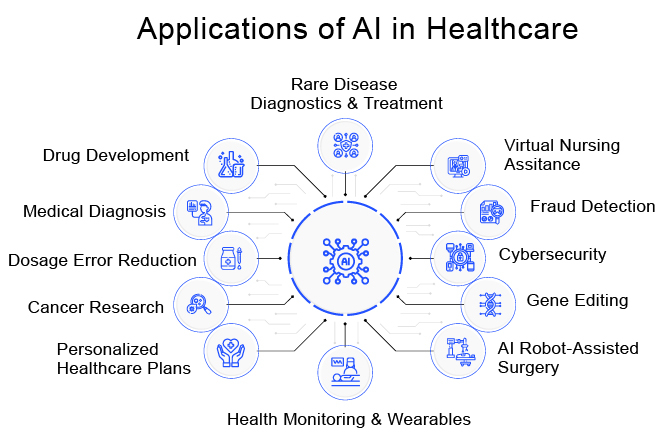AI used in Health Care
The Evolution of AI in Healthcare: Revolutionizing Patient Care

Introduction: In the realm of modern healthcare, the integration of Artificial Intelligence (AI) marks a significant milestone in advancing patient outcomes, optimizing processes, and revolutionizing the healthcare landscape. From diagnostics to treatment, AI applications are reshaping traditional approaches, offering unprecedented opportunities to enhance efficiency, accuracy, and accessibility in healthcare services. This essay explores the multifaceted role of AI in healthcare, highlighting its transformative impact on diagnosis, treatment, patient care, and healthcare management.
Diagnostics: One of the most promising applications of AI in healthcare is in diagnostics. AI-driven systems possess the capability to analyze vast amounts of medical data with remarkable speed and precision, aiding healthcare professionals in detecting diseases at early stages and making accurate diagnoses. Machine learning algorithms can sift through complex medical images such as X-rays, MRIs, and CT scans, identifying anomalies that might be missed by human eyes. For instance, in radiology, AI algorithms can assist radiologists in identifying tumors, fractures, or abnormalities with higher accuracy rates, reducing diagnostic errors and expediting treatment initiation. Moreover, AI-powered diagnostic tools can analyze patient data, including medical history, genetic information, and clinical symptoms, to generate personalized diagnostic recommendations, thereby improving patient outcomes and enhancing preventive care strategies.
Treatment:
In addition to diagnosis, AI is revolutionizing treatment approaches in healthcare. By leveraging machine learning algorithms, healthcare providers can develop personalized treatment plans tailored to individual patient needs. AI-driven decision support systems analyze patient data, clinical guidelines, and medical literature to recommend the most effective treatment options, taking into account factors such as patient demographics, medical history, and genetic predispositions. Furthermore, AI-enabled robotic systems are transforming surgical procedures, enabling surgeons to perform complex surgeries with greater precision, minimal invasiveness, and reduced recovery times. For example, robotic-assisted surgery in specialties like orthopedics and urology has demonstrated improved surgical outcomes, decreased complication rates, and enhanced patient satisfaction. Additionally, AI-powered virtual assistants and chatbots are enhancing patient engagement and adherence to treatment regimens by providing personalized health coaching, medication reminders, and real-time support, thereby fostering better patient-provider communication and continuity of care.
Patient Care: AI technologies are also enhancing the quality and efficiency of patient care delivery. Virtual health assistants equipped with natural language processing capabilities can interact with patients, triage their symptoms, and provide personalized health advice, reducing the burden on healthcare facilities and facilitating timely access to care. Moreover, AI-driven predictive analytics tools can identify high-risk patients who may require proactive interventions or preventive measures, enabling healthcare providers to allocate resources efficiently and prioritize patient care based on individual needs. Additionally, AI-powered monitoring devices and wearable sensors enable continuous remote monitoring of patients' vital signs, activity levels, and disease progression, empowering patients to take an active role in managing their health and facilitating early intervention in case of deterioration.
Healthcare Management: Furthermore, AI is reshaping healthcare management practices, optimizing administrative processes, and improving operational efficiency across healthccare organizations. AI-driven systems can analyze vast amounts of healthcare data, including electronic health records, billing information, and administrative records, to identify patterns, trends, and inefficiencies, enabling healthcare administrators to make data-driven decisions and streamline workflows. Predictive analytics tools can forecast patient demand, resource utilization, and healthcare trends, enabling hospitals and healthcare facilities to optimize staffing levels, inventory management, and resource allocation, thereby improving cost-effectiveness and enhancing overall healthcare quality.

Conclusion:
In conclusion, the integration of AI in healthcare represents a paradigm shift in the way healthcare is delivered, managed, and experienced. From diagnostics to treatment, patient care, and healthcare management, AI-powered solutions are revolutionizing every facet of the healthcare ecosystem, offering unprecedented opportunities to improve patient outcomes, enhance efficiency, and reduce healthcare costs. However, as AI continues to evolve, it is imperative to address ethical, regulatory, and privacy concerns to ensure responsible deployment and equitable access to AI-driven healthcare innovations. By harnessing the transformative potential of AI in healthcare, we can unlock new possibilities for delivering patient-centered, data-driven care and advancing the collective goal of improving health and well-being for all.
Compiled by: Pratiksha Bisht
Comments
Post a Comment